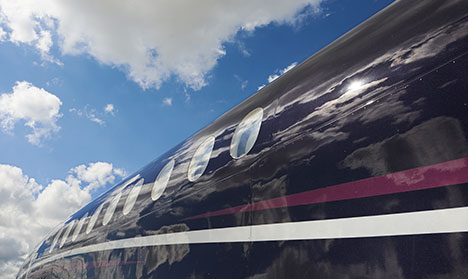

April 17, 2017
The paint on your aircraft is much more than decorative. Members of the NBAA Paint Forum want aircraft owners and operators to understand that aircraft paint is a complex protective system that requires care and maintenance with the same diligence afforded to other flight components, such as engines and control surfaces.
Paint Forum member Andrew Thomas, an engineer at Dassault Aircraft Services in Little Rock, AR, said paint “protects the structure from environmental conditions, chemicals and erosion.” Exterior aircraft paint provides crucial protection against corrosion and can improve the fuel efficiency of the aircraft, he added.
Members of the NBAA Paint Forum said they are battling misperceptions about the way aircraft surfaces are protected. Duncan Aviation’s Doug Bohac pointed out that many owner/operators view the paint on their aircraft the same way they view the paint on their cars. While a car retains the same shape and surface characteristics throughout its lifetime, he said, an aircraft is dynamic in comparison. “Unlike a car, airplanes expand and contract as they climb and descend because of varying air pressure,” explained Bohac.
In addition, aircraft operate in temperatures that can only be described as extreme. A business jet departing Phoenix, AZ, may take off in 110-degree heat, then climb to 45,000 feet, where the temperature is -60F – all in the span of just a few minutes. Airspeed in excess of 400 mph, airborne particles, rain, sleet and snow all wear on painted aircraft surfaces much more than on those of a car or boat.
Paint is also affected by the surface it covers, said Thomas. Composite aircraft components require very specific paint film thicknesses. Often, composite aircraft have the ability to flex in flight. That can lead to cracks and etching in the paint covering composite components within a year of application, Bohac added.
The longer operators wait to repaint their aircraft, the more chances they take with issues like corrosion, which can hide beneath both paint and sealer.
Dassault Falcon is experimenting with paints, protectants and application techniques, looking for ways to mitigate the cracks and etching found on composite surfaces.
The average paint job on a business aircraft operating in coastal areas where there is rain and a heavy concentration of corrosive salt in the air lasts approximately four years, said Bohac. In some places, where the air is drier and less corrosive, paint can remain effective longer. But both Bohac and Thomas say that the longer operators wait to repaint their aircraft, the more chances they take with issues like corrosion, which can hide beneath both paint and sealer.
“The paint on your aircraft constitutes a protective system,” said Eli Cotti, CAM and NBAA’s director of technical operations. “Rinsing and washing your plane are forms of required maintenance and should be viewed that way. Don’t shortchange this, because if you do, you might very well end up paying much more for repairs caused by neglecting an aircraft’s outer coating.”


 International Business Aviation Council Ltd.
International Business Aviation Council Ltd.